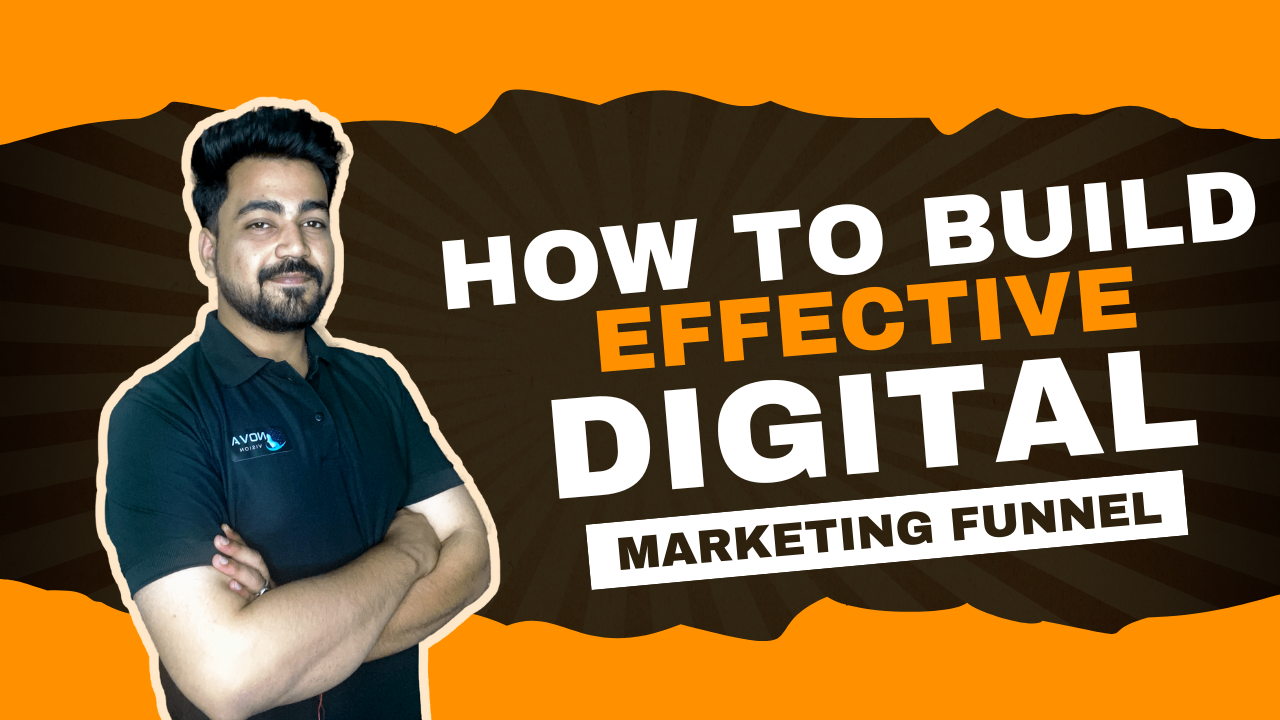
Top SEO Tips to Boost Your Organic Ranking and Traffic in 2025
In today’s rapidly evolving digital landscape, understanding and implementing an effective digital marketing funnel is crucial for businesses aiming to maximize conversions and ROI. A digital marketing funnel outlines the customer journey from awareness to conversion, guiding potential leads through strategic stages with tailored content and marketing tactics. In this comprehensive guide, we’ll explore how to build a powerful digital marketing funnel in 2025, enriched with fun facts, pro tips, tables, charts, and authoritative links.
We’ll delve into each stage of the funnel, discuss advanced strategies tailored for 2025, and provide practical tips for optimizing performance. This guide aims not just to educate but to inspire businesses to rethink their approach to digital marketing.
What is a Digital Marketing Funnel?
A digital marketing funnel represents the process businesses use to attract, engage, and convert potential customers into loyal advocates. It’s structured into different stages, each designed to nurture leads with targeted content and strategies. Think of it as a roadmap that helps potential customers move from being unaware of your brand to becoming passionate promoters.
Stages of a Digital Marketing Funnel:
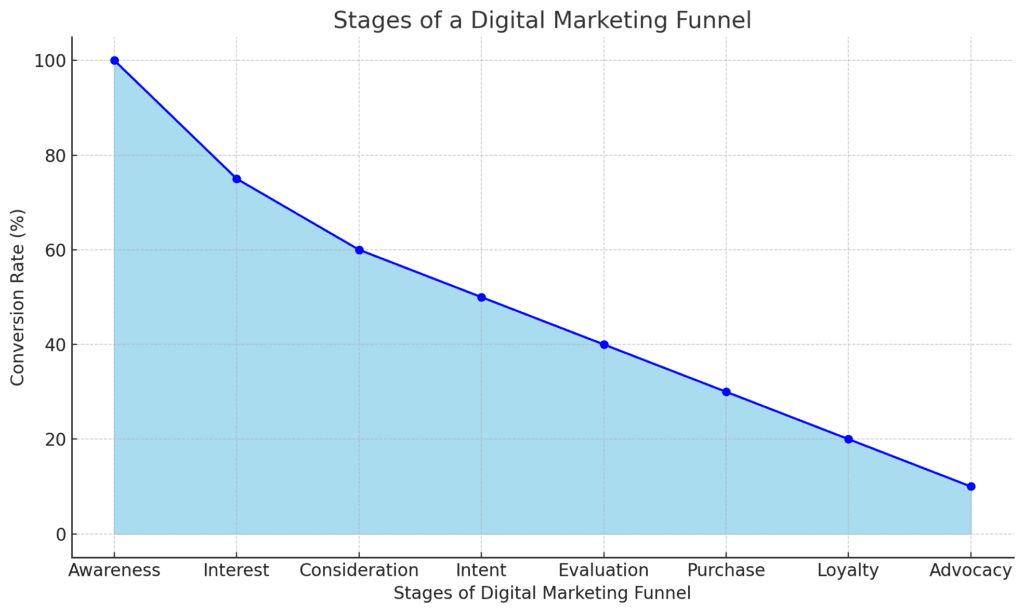
- Awareness:
- Objective: Make potential customers aware of your brand.
- Strategies: Use paid ads, social media content, SEO-optimized blog posts, influencer marketing, and PR campaigns.
- Example: A new fitness app runs Instagram ads showcasing quick workout routines. This grabs attention and introduces the brand to fitness enthusiasts.
- Interest:
- Objective: Engage potential customers with valuable content that piques their interest.
- Strategies: Publish engaging blog posts, informative videos, podcasts, newsletters, and webinars.
- Example: A SaaS company offers a free eBook titled “Top 10 Productivity Hacks for Remote Teams” to capture interest and collect emails.
- Consideration:
- Objective: Help leads evaluate their options and position your product/service as a top contender.
- Strategies: Use case studies, product comparison guides, testimonials, and expert reviews.
- Example: A digital marketing agency shares a case study showing how they helped a brand increase website traffic by 200% in six months.
- Intent:
- Objective: Demonstrate why your product/service is the best choice and encourage leads to take action.
- Strategies: Offer free trials, product demos, detailed pricing plans, and limited-time offers.
- Example: An e-commerce site sends a cart abandonment email with a special discount to encourage a potential customer to complete their purchase.
- Evaluation:
- Objective: Support leads as they critically assess their decision.
- Strategies: Provide personalized consultations, comparison charts, FAQs, and third-party reviews.
- Example: A software company offers a one-on-one demo with a sales expert to address specific questions and concerns from enterprise clients.
- Purchase:
- Objective: Convert leads into paying customers.
- Strategies: Simplify the checkout process, offer secure payment options, and highlight guarantees or return policies.
- Example: An online store provides a seamless checkout experience with multiple payment options and a “satisfaction guaranteed” badge to boost confidence.
- Loyalty:
- Objective: Retain customers and encourage repeat purchases.
- Strategies: Implement loyalty programs, send personalized follow-up emails, offer exclusive deals, and provide excellent customer support.
- Example: A coffee subscription service offers a points-based loyalty program where customers earn rewards for every purchase.
- Advocacy:
- Objective: Turn satisfied customers into brand advocates who refer others.
- Strategies: Encourage customer reviews, testimonials, social media shares, and referral programs.
- Example: A beauty brand launches a referral program where customers get a discount for every friend they refer who makes a purchase.
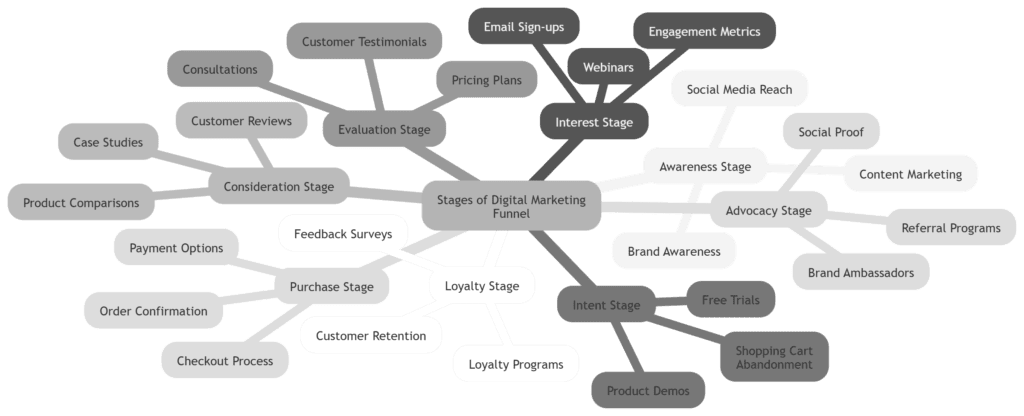
Why is a Digital Marketing Funnel Important in 2025?
The digital marketing landscape is becoming increasingly complex, with evolving consumer behaviors, emerging technologies, and the need for more personalized experiences. In 2025, a well-structured digital marketing funnel is not just an advantage; it’s a necessity.
1. Personalization at Scale:
- Explanation: Consumers no longer respond to generic marketing messages. They expect personalized experiences tailored to their preferences, behaviors, and interests. A marketing funnel helps deliver these personalized experiences effectively.
- Example: Netflix uses data-driven algorithms to recommend shows based on users’ viewing history. This level of personalization keeps users engaged and increases customer retention rates.
- Practical Tip: Use CRM systems and AI tools to segment your audience and deliver personalized email campaigns, dynamic website content, and tailored product recommendations.
2. Data-Driven Decisions:
- Explanation: In the age of big data, businesses have access to vast amounts of information about their customers. A digital marketing funnel allows marketers to analyze this data and make informed decisions to optimize each stage.
- Example: Amazon analyzes customer behavior to suggest products, optimize pricing, and improve the checkout process, resulting in higher conversion rates.
- Practical Tip: Implement tools like Google Analytics, HubSpot, or Salesforce to track user behavior, conversion rates, and campaign performance. Use A/B testing to refine marketing strategies continuously.
3. Omnichannel Engagement:
- Explanation: Consumers interact with brands across multiple channels—social media, email, websites, apps, and in-store experiences. A digital marketing funnel ensures that messaging is consistent and cohesive across all touchpoints.
- Example: Starbucks offers a seamless experience through its mobile app, website, and in-store services. Customers can order ahead, pay via the app, and earn rewards across platforms.
- Practical Tip: Use marketing automation tools to create integrated campaigns that deliver consistent messages across channels. Track customer interactions to understand their journey and optimize engagement.
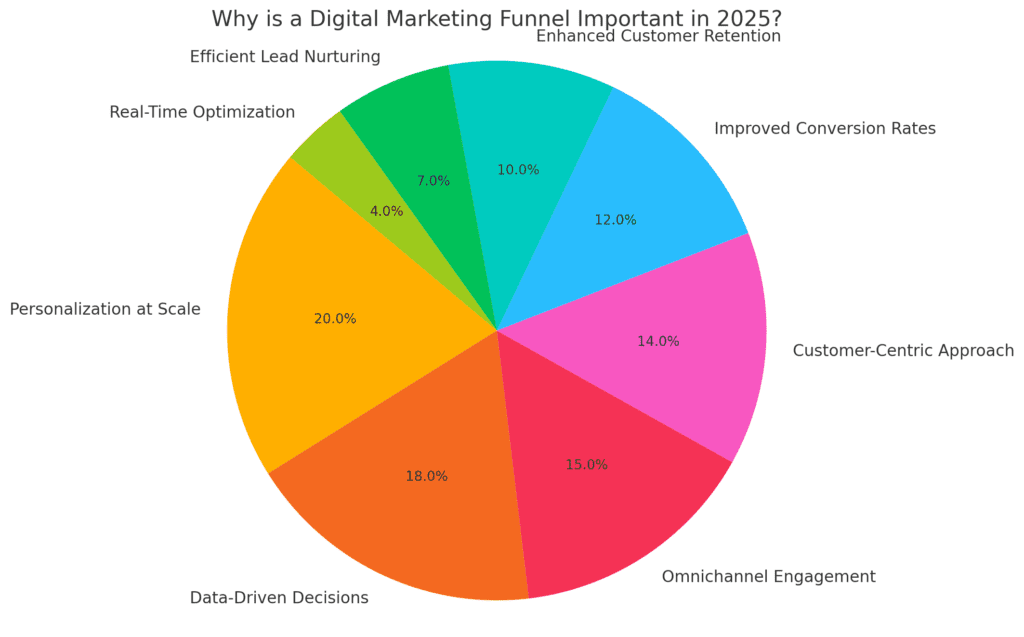
4. Customer-Centric Approach:
- Explanation: A digital marketing funnel shifts the focus from products to customers. It emphasizes understanding customer needs, pain points, and motivations, leading to more meaningful interactions and long-term relationships.
- Example: Apple focuses on creating exceptional customer experiences, from intuitive product design to personalized customer support. This customer-centric approach builds brand loyalty and advocacy.
- Practical Tip: Conduct customer surveys, analyze feedback, and use social listening tools to gain insights into customer preferences. Tailor your marketing strategies to address their specific needs.
Fun Fact: Did you know that companies with optimized marketing funnels experience a 10% higher conversion rate compared to those without structured funnels? Moreover, businesses that nurture leads effectively generate 50% more sales-ready leads at a 33% lower cost. Companies that prioritize customer experience outperform competitors by 60% in revenue growth.
Step-by-Step Guide to Building an Effective Digital Marketing Funnel in 2025
1. Define Your Target Audience
Understanding your target audience is the cornerstone of any successful marketing strategy. Without a clear idea of who your potential customers are, it’s challenging to create content that resonates.
- Conduct Market Research: Use surveys, focus groups, and competitor analysis to gather insights. For example, a fashion brand might survey customers about their style preferences or analyze competitors’ social media engagement.
- Create Detailed Buyer Personas: Develop fictional profiles representing your ideal customers. Include demographics (age, gender, location), behaviors (buying habits), goals, challenges, and pain points.
- Utilize Analytical Tools: Google Analytics, social media insights, and CRM systems provide valuable data on customer behavior.
Pro Tip: Use AI-powered tools like predictive analytics to anticipate customer needs and behaviors, enabling hyper-targeted marketing.
2. Create Engaging Awareness Content
The goal at this stage is to capture attention and introduce your brand to a broad audience.
- SEO-Optimized Blog Posts: Write informative articles on trending topics related to your industry. For example, a tech company might publish “Top 10 Emerging Technologies in 2025.”
- Infographics and Explainer Videos: Visual content simplifies complex topics. A finance app could create infographics explaining budgeting basics.
- Social Media Campaigns: Use trending hashtags, challenges, and user-generated content. For instance, a fitness brand could run a #30DayChallenge to engage users.
- Podcasts and Guest Appearances: Expand your reach by featuring on industry-related podcasts.
Fun Fact: Articles with images receive 94% more views than those without. Visual content significantly boosts engagement!
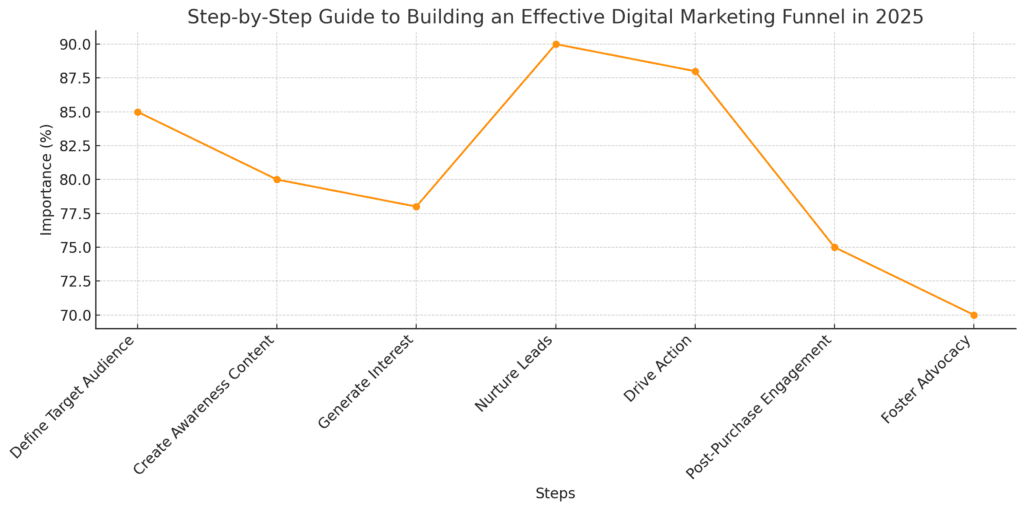
3. Generate Interest with Value-Driven Content
Once you’ve captured attention, keep your audience interested with valuable content that addresses their needs.
- E-books, Whitepapers, and Free Resources: Offer in-depth content like “The Ultimate Guide to Digital Marketing in 2025.”
- Webinars and Live Q&A Sessions: Engage in real-time. For example, a marketing agency could host a webinar on “SEO Best Practices for 2025.”
- Interactive Quizzes and Surveys: Create engaging tools like “Which Social Media Platform Suits Your Brand Best?”
Pro Tip: Offering exclusive content in exchange for email subscriptions helps build a high-quality lead list.
4. Nurture Leads in the Consideration Stage
Now that potential customers are aware of your brand, it’s time to nurture them toward making a decision.
- Case Studies: Showcase real-life success stories. A SaaS company might highlight how their software improved productivity for a client.
- Targeted Email Drip Campaigns: Send personalized emails based on user behavior. For example, follow up with webinar attendees with related content.
- Retargeting Ads: Re-engage visitors who showed interest but didn’t convert. Think of seeing ads for shoes you viewed last week.
- Comparison Guides and ROI Calculators: Help prospects evaluate options. A CRM provider could offer a calculator to show potential revenue growth.
5. Drive Action with Strong CTAs (Call-to-Actions)
Encourage potential customers to take the next step, whether it’s signing up, purchasing, or requesting a demo.
- Offer Free Trials or Demos: Let prospects experience your product firsthand. For instance, Netflix’s free trial hooks users into their service.
- Limited-Time Offers and Discounts: Create urgency. E-commerce sites often use “Flash Sales” to boost quick conversions.
- Personalized Recommendations: Use browsing history to suggest products. Amazon excels at this with their “Recommended for You” section.
- Social Proof: Display customer reviews, ratings, and testimonials prominently.
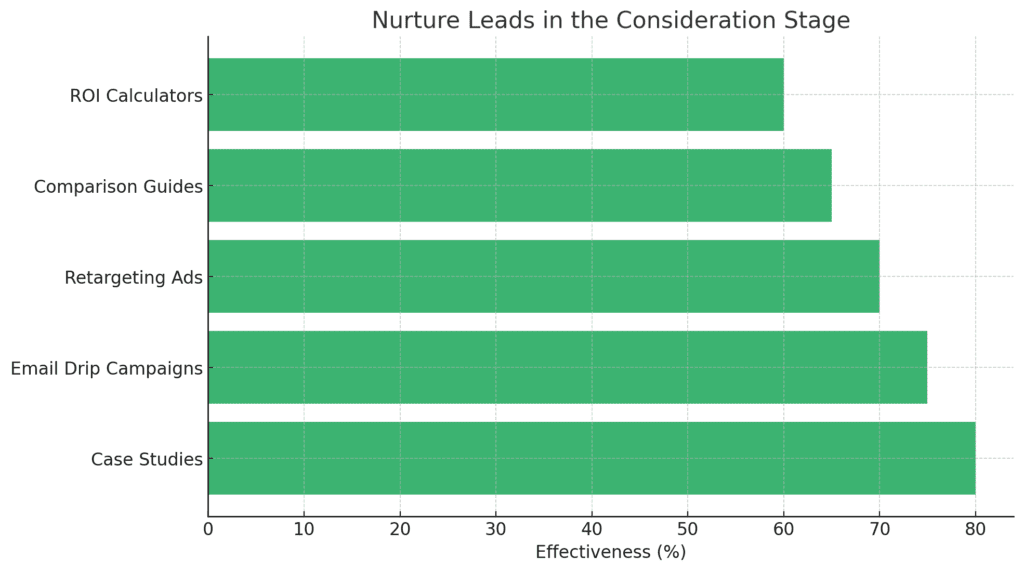
6. Post-Purchase Engagement
Your job isn’t over once a customer makes a purchase. Retaining customers is more cost-effective than acquiring new ones.
- Loyalty Programs: Reward repeat purchases. Starbucks’ loyalty app keeps customers coming back.
- Feedback Surveys: Gather insights to improve products. A hotel might send a post-stay survey asking about the guest experience.
- Educational Content: Help customers maximize product value. For example, a camera brand could offer photography tutorials.
- Personalized Thank-You Emails: Show appreciation with special offers or discount codes.
7. Foster Advocacy
Turn satisfied customers into brand advocates who refer others, leaving authentic testimonials and expanding your reach organically.
- Referral Programs: Encourage customers to refer friends. Dropbox famously grew its user base through a referral program offering extra storage.
- User-Generated Content: Feature customer photos or reviews on your website and social media.
- Encourage Reviews: Ask happy customers to leave reviews on platforms like Google or Trustpilot.
- Brand Ambassador Programs: Identify loyal customers and incentivize them to promote your brand.
Pro Tip: Happy customers are your best marketers. Offer incentives for referrals, but ensure the quality of service speaks for itself.
Key Metrics to Measure Funnel Performance
Stage | Key Metrics | Tools to Use |
Awareness | Impressions, Reach, Website Traffic | Google Analytics, SEMrush |
Interest | Engagement Rate, Bounce Rate | Social Media Insights, Hotjar |
Consideration | Lead Conversion Rate, Time on Page | CRM Systems, HubSpot |
Intent | Click-Through Rate (CTR), Demo Requests | Google Ads, Mailchimp |
Evaluation | Sales Qualified Leads (SQLs), ROI | Salesforce, Pipedrive |
Purchase | Conversion Rate, Average Order Value | E-commerce Analytics Tools |
Loyalty | Customer Lifetime Value, Referral Rate | Loyalty Program Software |
Advocacy | NPS Score, User-Generated Content | Survey Tools, Social Listening |
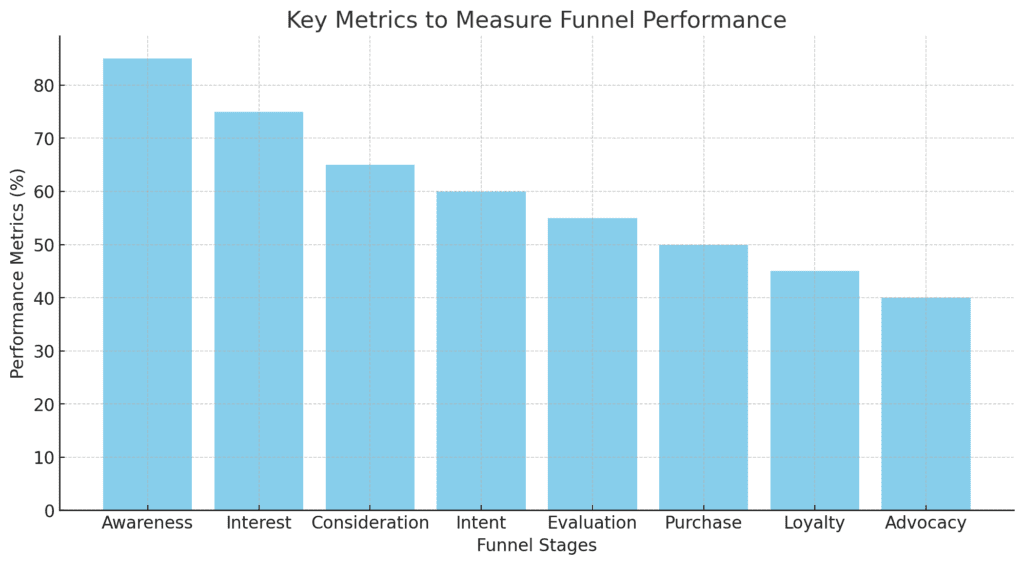
Visual Representation of a Digital Marketing Funnel
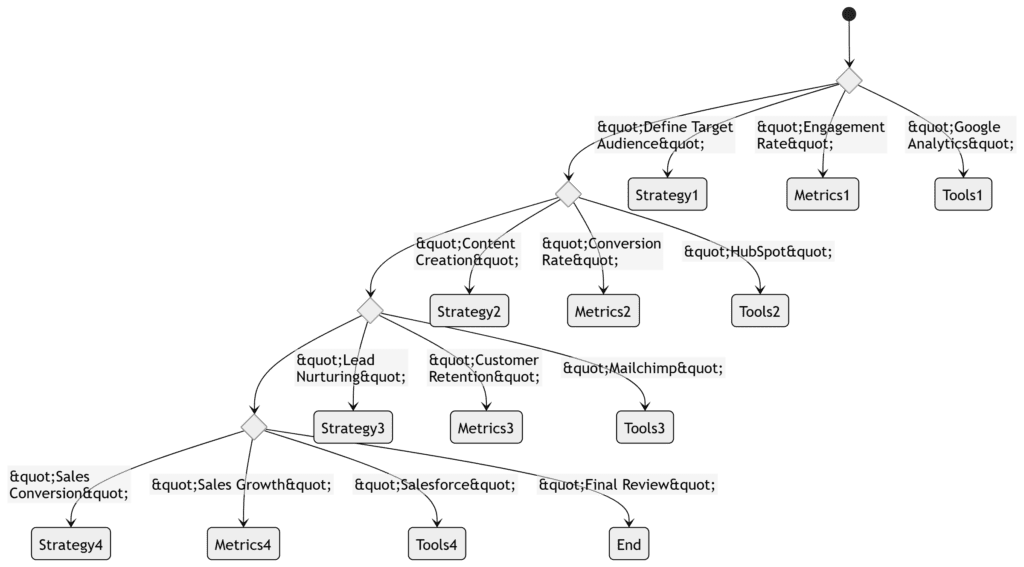
Advanced Funnel Strategies for 2025
The digital marketing landscape in 2025 is more dynamic than ever, requiring advanced strategies to stay ahead. Here’s an in-depth look at cutting-edge approaches that can elevate your marketing funnel:
- AI and Automation:
- What It Is: Using artificial intelligence to automate repetitive tasks, analyze data, and personalize customer interactions.
- Practical Example: E-commerce platforms like Amazon use AI to recommend products based on browsing history, increasing conversion rates.
- How to Apply: Implement AI-driven tools for predictive analytics to identify high-potential leads and automate email marketing workflows to nurture them effectively.
- Voice Search Optimization:
- What It Is: Adapting your content for voice-activated devices like Alexa, Siri, and Google Assistant.
- Practical Example: A local restaurant optimizes its website for phrases like “best pizza near me,” capturing traffic from voice search queries.
- How to Apply: Focus on natural language keywords and FAQs to improve your website’s voice search rankings.
- Interactive Content:
- What It Is: Engaging users through interactive experiences such as polls, quizzes, and augmented reality (AR).
- Practical Example: A beauty brand offers a virtual makeup try-on using AR, increasing customer engagement and sales.
- How to Apply: Create interactive infographics, calculators, or assessments to capture user attention and collect data.
- Video Marketing Dominance:
- What It Is: Leveraging the power of video to convey your message quickly and effectively.
- Practical Example: Brands like Nike use storytelling in short-form videos on Instagram Reels to connect emotionally with their audience.
- How to Apply: Produce product demos, behind-the-scenes content, and customer testimonials in video format to build trust and drive conversions.
- Personalized Email Marketing:
- What It Is: Sending targeted emails based on user behavior and preferences.
- Practical Example: Spotify sends personalized “Year in Review” emails, showcasing individual listening habits, which boosts user engagement.
- How to Apply: Use dynamic content in emails to tailor product recommendations, offers, and content for each subscriber.
- Zero-Party Data Collection:
- What It Is: Collecting data that customers willingly provide, such as preferences and feedback.
- Practical Example: A fashion retailer asks customers to select their style preferences during sign-up, improving personalized recommendations.
- How to Apply: Use surveys, preference centers, and interactive quizzes to gather zero-party data for better personalization.
- Sustainability Messaging:
- What It Is: Communicating your brand’s commitment to sustainability and ethical practices.
- Practical Example: Patagonia’s marketing focuses on environmental activism, resonating with eco-conscious consumers.
- How to Apply: Highlight eco-friendly initiatives in your campaigns, such as using sustainable materials or supporting environmental causes.
Pro Tip: Implement chatbots to enhance customer support and lead nurturing, increasing conversion rates by up to 25%. AI-powered chatbots can handle 80% of routine inquiries, freeing up human resources for complex tasks.
Bonus Tip: Combine these strategies for maximum impact. For example, use AI to segment your email list based on zero-party data and send personalized, sustainability-focused video content. This multi-faceted approach ensures your funnel remains effective in the evolving digital landscape.
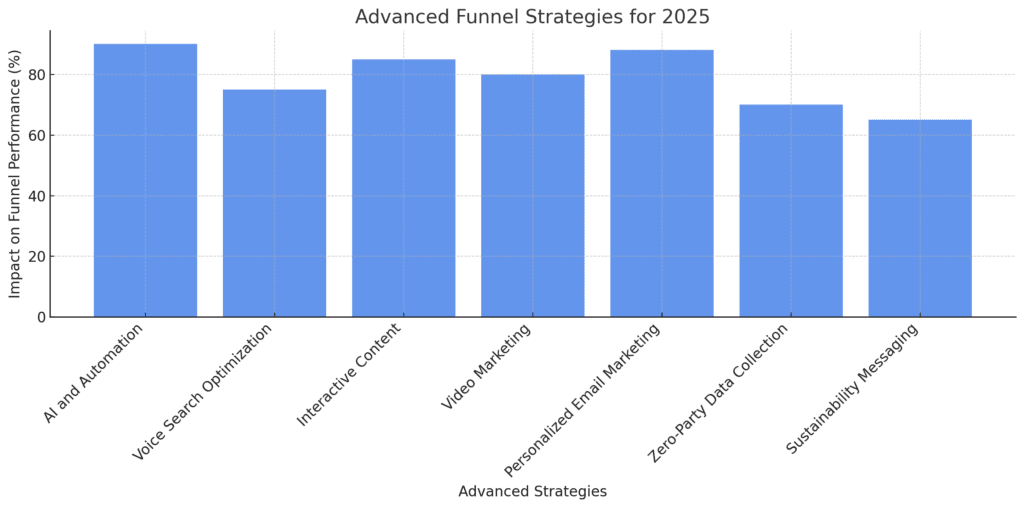
Common Mistakes to Avoid
While building a digital marketing funnel, many businesses fall into common pitfalls that can hinder performance and reduce conversions. Here’s an in-depth look at these mistakes, why they occur, and how to avoid them:
1. Ignoring Mobile Optimization
- Why It’s a Problem: With over 60% of web traffic coming from mobile devices, neglecting mobile optimization can lead to poor user experiences, high bounce rates, and lost conversions.
- Example: An e-commerce site with a slow-loading mobile version may frustrate users, causing them to abandon their carts.
- How to Avoid:
- Use responsive design to ensure your site adapts to different screen sizes.
- Optimize images and improve loading speeds.
- Test your website’s mobile performance using tools like Google’s Mobile-Friendly Test.
Pro Tip: A delay of just one second in mobile load time can reduce conversion rates by 7%.
2. Focusing Solely on Acquisition While Neglecting Retention
- Why It’s a Problem: Acquiring new customers is often more expensive than retaining existing ones. Failing to nurture current customers can result in missed opportunities for repeat business and brand advocacy.
- Example: A subscription service offers heavy discounts to attract new users but doesn’t engage existing subscribers, leading to high churn rates.
- How to Avoid:
- Implement loyalty programs to reward repeat customers.
- Regularly engage your audience through personalized email campaigns.
- Gather feedback to improve products and services.
Fun Fact: Increasing customer retention rates by 5% can boost profits by up to 95%.
3. Poor Segmentation of Audiences
- Why It’s a Problem: Treating all leads the same can result in generic, irrelevant messaging that fails to resonate with specific audiences, reducing engagement and conversions.
- Example: Sending the same promotional email to both first-time visitors and loyal customers can confuse or annoy recipients.
- How to Avoid:
- Use CRM tools to segment your audience based on demographics, behavior, and purchase history.
- Personalize content and offers for each segment.
- Continuously analyze and adjust segments as customer behaviors evolve.
Pro Tip: Personalized emails deliver 6x higher transaction rates compared to generic messages.

4. Inconsistent Brand Messaging Across Channels
- Why It’s a Problem: Inconsistent messaging can dilute your brand identity and confuse potential customers, especially when they encounter mixed messages on different platforms.
- Example: A brand’s Instagram highlights eco-friendliness, while its website focuses solely on luxury, creating a disconnect.
- How to Avoid:
- Develop a clear brand voice and messaging guidelines.
- Ensure consistency across all marketing channels, including social media, email, website, and ads.
- Regularly audit your content to maintain alignment.
Fun Fact: Brands with consistent messaging see a 23% increase in revenue compared to those without.
5. Overlooking Data Privacy Regulations
- Why It’s a Problem: Non-compliance with data privacy laws like GDPR and CCPA can lead to hefty fines, legal issues, and loss of customer trust.
- Example: A company collects user data without proper consent, resulting in legal action and damaged reputation.
- How to Avoid:
- Stay updated on global data privacy regulations.
- Implement transparent data collection practices with clear consent forms.
- Provide easy options for users to manage their data preferences.
Pro Tip: Displaying a clear privacy policy can boost user trust, leading to higher conversion rates, especially in regions sensitive to data protection.
FAQ
Conclusion
Building an effective digital marketing funnel in 2025 requires a strategic blend of data-driven insights, personalized content, and advanced technology. By understanding the customer journey, optimizing each stage, and leveraging innovative tools, businesses can drive higher conversions and foster lasting customer relationships.
As marketing continues to evolve, staying adaptable and informed will be key. For expert guidance on implementing cutting-edge digital marketing strategies, contact Nova Vision Media Tech. Let’s elevate your marketing game to the next level with customized solutions tailored to your business goals!


